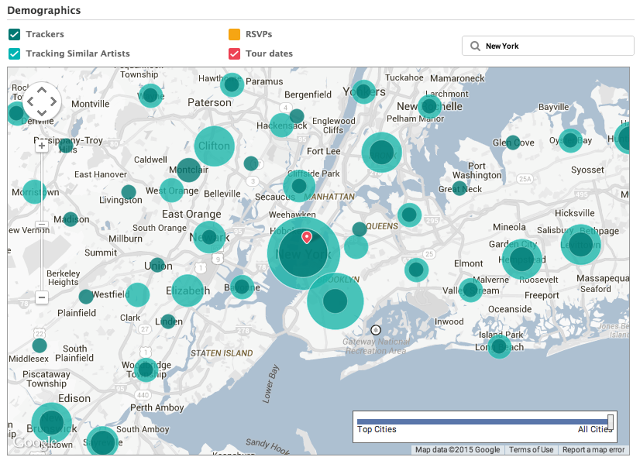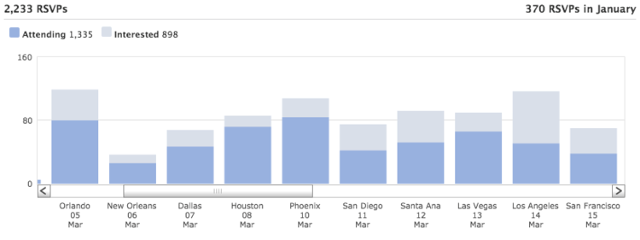In Lieu Of Royalties, Music Apps Are Feeding Starving Musicians With Data
The latest analytics offering from the app Bandsintown lets artists see their fans on a map so they can better plan their tours.
At a time when musicians earn meager royalties from streaming services, a host of music-focused apps are making a new, largely unspoken peace offering to artists: data.
The wealth of analytics offered by a host of live music apps can’t be spent on food, instruments, or clothes. Instead, the idea is that bands equipped with data about their audience should be able to better cater to their fans and locate them too, so they can, for instance, plan tours around where they live.
The concert-tracking app Bandsintown is the latest to use data to try and entice artists to use its tour services. Backed by data from the app’s 15 million users, these fans aren’t just RSVPing for shows and buying tickets: They’re also showing artists exactly where they should be playing shows to please the most people—and maybe sell a few extra T-shirts. This week, the concert-finding service is adding “behavioral analytics” to its artist-focused Bandsintown Manager app.

Once an artist adds their tour to Bandsintown (and has more than 100 followers) the Bandsintown Manager app will now show four key analytics: an RSVP map, top 100 cities, follower growth, and upcoming RSVPs.
The RSVP analytics will show touring musicians where fans are RSVPing from, relative to upcoming tour dates, as well as where an artist’s followers are, and where fans are tracking similar bands. The map shows data worldwide with the ability to search for any location, from the continent to the city level, helping reveal, for instance, if fans are coming from far away, or where to plan upcoming shows. Bandsintown says 250,000 artists now use its platform to promote their live shows, and that 66,000 artists have joined in the past year.
Besides helping artists schedule more last-minute promotion for dates where attendance looks low, this data could also help make sure high-volume shows have plenty of merchandise on hand. The data could mean the difference between blindly scheduling a tour in known cities compared to heading into fan-rich hotspots.
“For decades, labels were the sole owner and beneficiary of artist data they collected from their licensees and distributors, with little insights shared back to artists,” Julien Mitelberg, Bandsintown president and COO, told Fast Company. “Our social media marketing platform provides free tools that work for artists, to maximize ticket sales, which are already a primary and healthy source of income.”
Citing privacy concerns, Mitelberg said, Bandsintown’s platform doesn’t allow artists to specifically identify individual fans or see personal data like gender or contact info.
Other concert-tracking apps, like Songkick, StubHub Music, WillCall, Live Nation, and Crowdsurge, are also offering artists and venues a range of services that aim to enrich the concert-planning experience with more data.
“By enabling artists to go direct-to-consumer with a portion of their tickets, Crowdsurge is able to collect data on their behalf that is generally unavailable to them from traditional ticketing companies,” Crowdsurge CEO Matt Jones told me last year.

Pandora opened its analytics to artists late last year (called AMP) in an attempt to make its music platform friendlier to artists. In addition to which songs plays and thumbs-up information, Pandora also offers an interactive heat map of listeners across the U.S.. It falls under the general idea that if artists, and their managers, know the locations of interested listeners, they can capitalize on touring and make more money.
Spotify has had artist analytics since the end of 2013. Unlike Pandora or Bandsintown, Spotify’s efforts mostly focus on revenue and song popularity, though Spotify did add ticketing options inside its app to entice listeners. Spotify’s analytics were provided by the third-party service Next Big Sound instead of in-house, but that should change with the acquisition of The Echo Nest last year.
More and more streaming music services aren’t just serving consumers audio, they’re also becoming data companies serving up information to artists and rights holders. While a hit song is key to success, knowing where people are listening to that song is becoming just as important.
(195)














